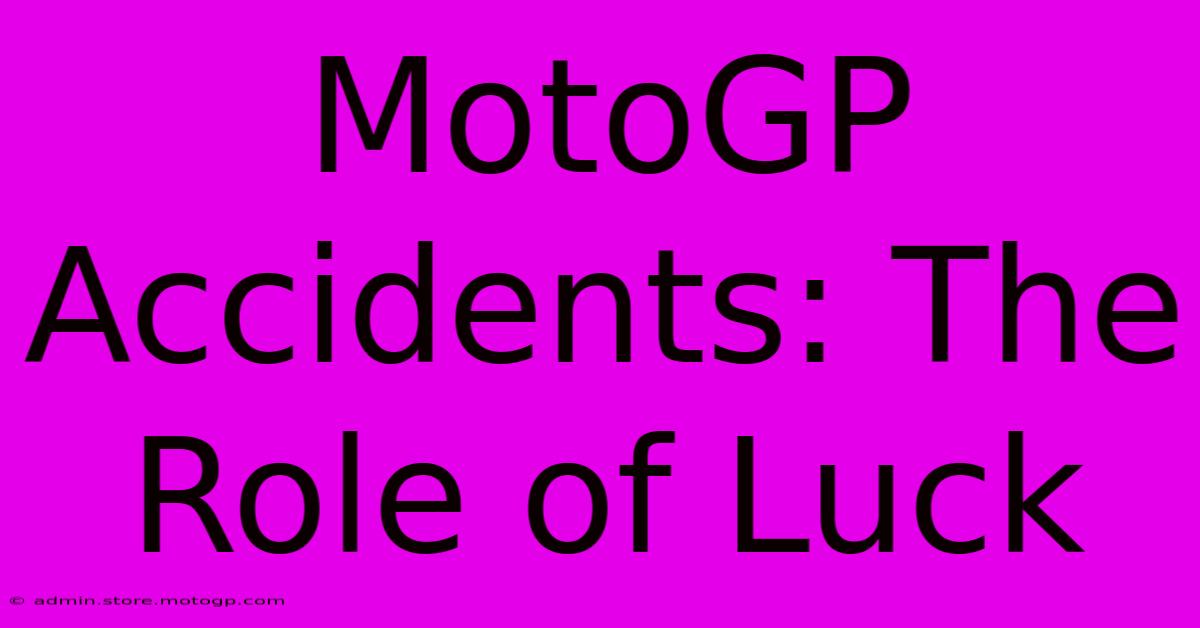MotoGP Accidents: The Role Of Luck

Table of Contents
MotoGP Accidents: The Role of Luck
MotoGP racing, a spectacle of speed, skill, and breathtaking maneuvers, is inherently dangerous. While rider skill and technological advancements play crucial roles in minimizing risk, the undeniable truth is that luck, both good and bad, significantly impacts the outcome of races and, tragically, sometimes the riders' well-being. This article explores the unpredictable element of chance in MotoGP accidents and how it intertwines with the other factors at play.
The Unpredictable Nature of Accidents
MotoGP accidents are rarely simple collisions. They're complex events resulting from a confluence of factors, often escalating from seemingly minor incidents. A small wobble, a sudden gust of wind, a momentary lapse in concentration – these seemingly insignificant events can trigger a chain reaction leading to a major crash. This inherent unpredictability highlights the significant role of luck.
Human Error vs. Mechanical Failure vs. Sheer Bad Luck
While rider error and mechanical failures are frequently cited as causes of accidents, it's often a combination of factors, with a hefty dose of bad luck thrown in. A rider might make a minor mistake, but a fortunate circumstance (or perhaps an unfortunate one for another rider) prevents a serious incident. Conversely, a seemingly minor mechanical failure could have catastrophic consequences if it occurs at an inopportune moment. This is where luck intervenes, magnifying or mitigating the impact of other variables.
The Role of Other Riders
The unpredictable nature of MotoGP accidents is further amplified by the presence of other riders. A seemingly innocuous incident involving one rider can quickly escalate into a multi-bike pile-up, leaving several racers injured or out of the race. Being in the wrong place at the wrong time can be the difference between a minor scrape and a significant injury, underscoring the role of luck in determining the severity of the consequences.
Good Luck and Near Misses
Just as bad luck can lead to serious accidents, good luck can prevent them. This manifests in numerous ways:
- Avoiding a Collision by a Hair's Breadth: Many riders have recounted near misses where a fraction of a second, a slight adjustment in their line, or a fortunate bounce of the bike prevented a potentially devastating crash.
- Landing in a Safe Zone After a Crash: The way a rider falls and the location of the impact can be dramatically affected by chance. Landing in a safer area of the track, away from other riders or obstacles, can significantly reduce the severity of injuries.
- The Quick Response of Medical Teams: The speed and efficiency of the medical response teams at MotoGP races are crucial. While their skill is a given, the timely arrival and swift action of the medical personnel could be considered a form of "good luck" for the injured rider.
Minimizing Risk: Skill, Technology, and Safety Regulations
While luck plays a role, MotoGP is not solely reliant on chance. Significant efforts are made to mitigate risk:
- Rider Skill: Years of intense training and experience are essential for riders to develop the skills necessary to handle the high-speed demands of MotoGP.
- Technological Advancements: Continuous improvements in motorcycle technology, safety equipment, and track design play a crucial part in reducing the likelihood of accidents.
- Safety Regulations: Strict safety regulations and ongoing research are constantly implemented to improve rider safety and minimize the risk of accidents.
Conclusion: A Complex Equation
MotoGP accidents are a complex interplay of skill, technology, and the unavoidable element of luck. While advancements in safety and rider skill minimize risks, the unpredictable nature of racing means that luck, both good and bad, will always play a significant, sometimes decisive, role. Understanding this complex equation is essential for appreciating the bravery and skill of MotoGP riders, as well as the inherent risks involved in this thrilling sport.

Thank you for visiting our website wich cover about MotoGP Accidents: The Role Of Luck. We hope the information provided has been useful to you. Feel free to contact us if you have any questions or need further assistance. See you next time and dont miss to bookmark.
Featured Posts
-
Cota Parking Your Guide To Easy In Easy Out
Feb 18, 2025
-
Austin Gp Concert The Must See Music Event Of The Racing Season
Feb 18, 2025
-
Moto Gp Helmets Find Your Perfect Fit Today
Feb 18, 2025
-
Cota One Day Pass Seamless Columbus Exploration
Feb 18, 2025
-
F1 Us Grand Prix Watch The Race In Style Tv Coverage
Feb 18, 2025
